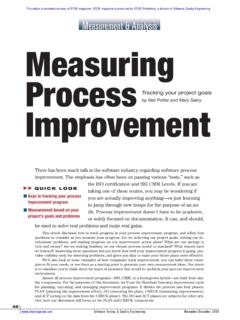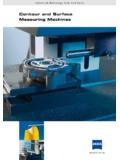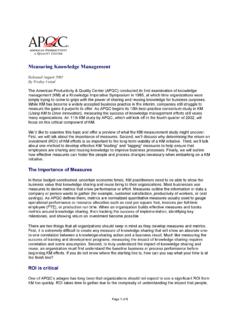Transcription of THE SIX FACTORS OF Knowledge Worker …
1 THE SIX FACTORS OFKnowledge Worker ProductivitySIX FACTORS THAT CAN CHANGE YOUR ORGANIZATIONANDREW MAWSONFOREWORD BY JAN JOHNSON3 FOREWARDOur industry has been hunting the elusive workplace "holy grail" for years a universal, dependable, repeatable way to measure Knowledge Worker productivity hoping it would help us to identify (and defend to the skeptics) aspects of the workplace that can be proven to positively affect performance. So what if we could truly and reliably improve Knowledge Worker effectiveness? To create value for our organizations far beyond controlling costs? The role of the physical workplace in increasing productivity has always been the hardest to pin down, but the greatest opportunity. Reader, you hold in your hand something rather unique in our industry: insights into Knowledge Worker productivity firmly grounded in real science. This book summarizes a research project undertaken by London-based Advanced Workplace Associates (AWA) and Amsterdam-based Center for Evidence-Based Management, for which Allsteel was one of several was thrilled to fund this work for two main reasons: these findings are the best available evidence and backed up by scientific rigor (vs.)
2 Opinion surveys or other junk science ); and they give us far more specific, truly actionable insights than are typically a part of a discussion about engagement. Taken together the bulletproof quality of the information described here and its clarity about what really matters we now have data and insights that can truly add value. And, a much-needed piece of the workplace puzzle: we ve known for some time that the workplace must effectively support the most critical activities that make up work, and now this new material clarifies the interpersonal relationships and behaviors the workplace must also enable. This research gives us credible, powerful Knowledge to share with senior leadership. Organizations can use this information to drive greater enterprise alignment and to hone leadership and management behaviors, performance management systems and other HR programs, workplace design, and technology strategies. Stay and Allsteel are piloting tools and interventions that apply this tremendous JohnsonVP Design and Workplace ResourcesAllsteel5 The Six FACTORS of Knowledge Worker ProductivityThe term " Knowledge Worker " was originally coined by the great Peter Drucker in 1956.
3 Knowledge workers include leaders, designers, researchers, architects, software designers, engineers, consultants, analysts, scientists, writers, film producers, animators, and so on. Over the last 30 years or more, business leaders have been focused on improving the productivity of their organizations. For many, their thinking is likely shaped by linear, measurable manufacturing environments where you can work out the number of items produced and the resources that were linked to their production to come up with a few simple metrics. This enabled them to compare one plant against another, one location against another, one organization against another, and perhaps even one nation against another. Additionally, these measures made it somewhat straightforward to determine what lever to pull or which factor in the equation to try to is still a relevant mindset in the world of manufacturing, and even in those service industries where people repeat broadly the same linear process over and over again in the delivery of a service; the ways to manage in the worlds of process and manufacturing are well-charted.
4 But it has been clear for some time that equivalent measures or reasonably universal methodologies do not exist for Knowledge industries. Knowledge work is too varied, non-linear, and complex. For example, it can be difficult to tease apart what individual contributions make up the new product vs. how many came from the collective mind of the team, and the value of the outcome is likely to be determined by each consumer, not some objective, universally applicable standard of quality or though the term Knowledge work has been around since the 1950s, and Knowledge work plays an ever-increasing part in the economic fortunes of developed countries, there is little science on Knowledge work productivity . So with this conundrum as a backdrop, and given that our clients are all organizations that operate in the Knowledge economy to one degree or another, in early 2014 Advanced Workplace Associates (AWA) decided to undertake research to answer Chapter O1 The Six FACTORS of Knowledge Worker Productivity7what we felt were unanswered questions about Knowledge work and the FACTORS that had the most impact on Knowledge Worker productivity .
5 We wanted the research to be credible, scientific, and unbiased, and for its results to have the capability of being translated into business language, to give leaders practical guidance on what they should do to make a real difference for their organizations. We wanted to get to what we ll describe below as the best available evidence. Over the years, I've gotten to know Rob Briner, Professor of Psychology at Bath University, here in the UK. Rob has spoken at several of our events, and we ve enjoyed many cups of coffee where we d put the world to rights. It was at one of these sessions that I revealed our desire to undertake research in this area. Rob told me about his involvement with an Amsterdam-based group called the Center for Evidence-Based Management (CEBMa), a global network of science-based academics who teach, preach, and practice something called evidence-based management. Once he d explained its approach and methodologies, it became obvious that we should form a research partnership to answer our questions using CEBMa's rigorous, science-based 2014, we and several sponsors launched our first joint research project on Knowledge Worker productivity with CEBMa CEO Eric Barends and his team, in which we would work together to scientifically answer research questions and translate the results into tools, guidance, and understandings that could be used to make organizations more successful by making their workers more effective.
6 Since then, we ve maintained a very successful partnership in which we ve applied CEBMa's methodology to unearth the science behind several other questions associated with the link between work, human performance, the workplace, and organizational performance. Our sponsors BP, The Royal Bank of Scotland, Old Mutual, The British Council, Allied Bakeries, Telereal Trillium, and Allsteel were invited to contribute their practical understandings of the challenges their organizations and clients faced to the setting of the research questions. The mix of representatives from the sponsors was interesting too, involving HR directors, chief operating officers, global heads of real estate, and real estate directors. This eclectic group later proved to be a valuable resource in the interpretation stage of the program. While their involvement in these stages was sought, they had no other influence on the research process or findings, so no one could question whether the research played to a particular commercial interest or off, CEBMa used its highly efficacious Rapid Evidence Assessment (REA) methodology to undertake a review of the world s most credible academic databases in search of answers to the questions the group crafted: What is known from the world s academic research about the measurement of Knowledge Worker productivity ?
7 And What is known about the FACTORS associated with Knowledge Worker productivity and their effects? The REA methodology involves identifying relevant studies, reviewing their contents, filtering for relevance to research questions, grading the research (for instance, a randomized trial conducted in a scientific manner scores higher than an expert opinion), and clustering the studies in relation to specific topic areas. What emerged was an enormous amount of information and credible answers to our research questions. We believe that when the leaders of the world s great Knowledge businesses understand and apply this information, they will have a profound impact on their organizations culture and leadership competences and the design of workplace infrastructure. The findings provide new requirements for everything associated with the organization. Intriguingly, the findings are all about organizational effectiveness and culture not design, technology, or agile working.
8 And, once they are understood, they change everything and put a great many things into a unified this book, we ll reveal the information and insights that came from our research, and explore what they mean for each discipline in the business, and how, quite simply, the research findings change ManagementWhen Rob Briner first explained to me the concept of evidence-based management, my first thought was that we all already do that, don t we? Let s face it, as leaders, we think we make decisions based on scientific evidence and logic. Rob very quickly put me straight and explained that, in fact, this was not true: that in most cases we use intuition, experience, and hunches to make decisions. And the more senior we become, the more we tend to rely our own experience and intuition instead of on hard evidence. As I looked back on my experiences as an employee, a consultant, and as a senior leader in the IT industry, I started to see his point. The basic idea of evidence-based practice is that good-quality decisions should be based on a combination of critical thinking and the best available evidence.
9 And although most management practitioners might use evidence in their decisions, many pay little attention to the quality of that evidence. The result is often misguided decisions based on unfounded beliefs, fads, and ideas popularized by management gurus. The bottom line is poor outcomes and limited understanding of why things went wrong. Evidence-based practice seeks to improve the way decisions are made. It is an approach to decision-making and day-to-day work practice that helps practitioners critically evaluate the extent to which they can trust the evidence they have at hand. It also helps practitioners to identify, find, and evaluate additional evidence that would be relevant to their decisions. Evidence-based practice is about making decisions through the conscientious, explicit, and judicious use of the best available evidence from multiple sources by:1. Asking: translating a practical issue or problem into an answerable question2. Acquiring: systematically searching for and retrieving the evidence 3.
10 Appraising: critically judging the trustworthiness and relevance of the evidence4. Aggregating: weighing and cross-referencing the evidence5. Applying: incorporating the evidence into the decision-making process6. Assessing: evaluating the outcome of the decision takenWhen we say, evidence, we basically mean verifiable, repeatable data and information. It may be quantitative or qualitative. Evidence may come from scientific research suggesting generally applicable facts about the world, people, or organizational practices. Evidence may also come from local organizational or business indicators, such as company metrics or observations of practice conditions. Even professional experience can be an important source of evidence for example, an entrepreneur s past experience of setting up a variety of businesses should indicate the approach that is likely to be the most successful. Chapter O2 Evidence-BasedManagement11of the organization s culture or attitudes toward senior management.










